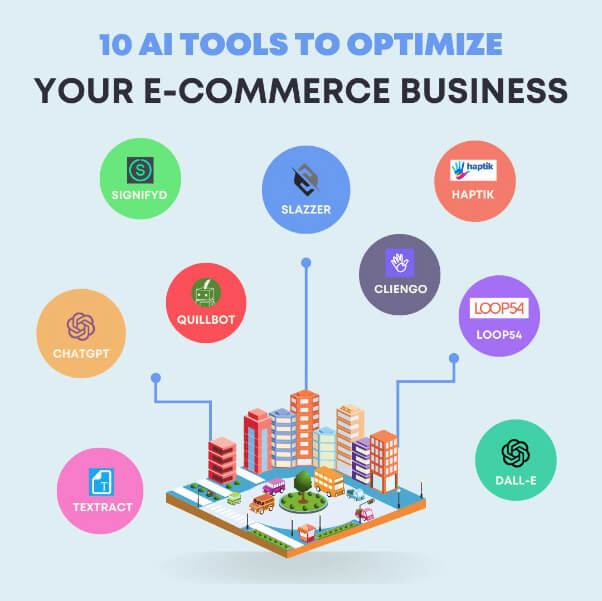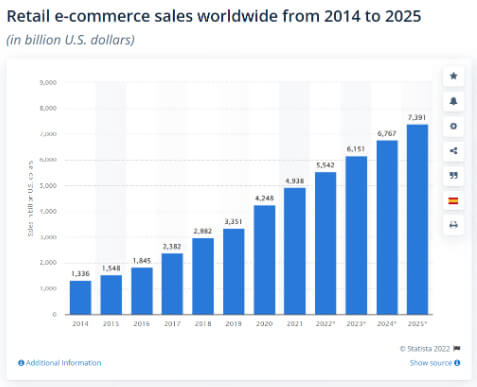- Tips & Tricks
- Jan 31, 2023
10 AI Tools to Optimize Your E-commerce Business in 2023

As the e-commerce industry continues to rapidly evolve, businesses are constantly on the hunt for new and innovative ways to boost efficiency, drive sales, and provide unparalleled customer service. Enter Artificial Intelligence (AI) – the game-changing technology that’s taking the business world by storm. With the power of AI-driven tools, e-commerce businesses can now easily streamline processes, automate mundane tasks, and gain valuable insights to improve performance. In this article, we’ll dive into a few standout tools of AI and Natural Language Processing (NLP) and discover how they can be used to supercharge your e-commerce business. From automating customer service to optimizing product images and enhancing WhatsApp marketing strategies, the possibilities are endless.
The e-commerce industry, the buying and selling of goods and services through the internet, is projected to reach a staggering $7.3 trillion by 2025.

It has become an increasingly popular way for businesses to reach a wider audience and for consumers to shop for products and services from their homes. Some key aspects of e-commerce include online payment systems, shipping and logistics, and marketing. Online payment systems allow businesses to process transactions and securely accept customer payments. Shipping and logistics involve the transportation and delivery of goods to customers. Marketing includes promoting products and services to potential customers through various channels, such as social media and search engine optimization.
To succeed in the world of e-commerce, businesses must have a strong online presence and be able to manage all of these aspects of their operations effectively. AI tools can be a valuable asset in helping businesses to streamline and optimize their e-commerce processes, resulting in increased efficiency and profitability.
We will review:
- Slazzer: A background removal application powered by AI.
- Quillbot: A language processing tool that can rewrite and paraphrase text
- ChatGPT: A chatbot tool that uses GPT-3 technology to generate human-like responses
- Dall-E: A tool that can generate original images and videos based on written descriptions
- Textract: A tool that can extract text and data from documents and images
- Cliengo: A customer engagement service used for websites.
- Haptik AI: A conversational AI platform that enables businesses to automate customer service and support through chatbots and virtual assistants in a variety of channels.
- Yext: A listing tool that assists customers in finding a business regardless of where they search.
- Signifyd: An AI-based fraud detection solution for e-commerce businesses, helping them identify and prevent fraudulent activities.
- Loop54: An intelligent and automated search-site and navigation software designed to help eCommerce websites and businesses provide a personalized product searching
1. Slazzer
Slazzer is an AI-powered image editing platform that can automatically remove backgrounds from images at scale. It uses deep learning algorithms to perform image segmentation and object recognition tasks, allowing it to accurately identify and separate the subject of an image from its background with the best detailing. The platform can be accessed via an API that e-commerce businesses can integrate into their website or app, as well as a desktop app that can be used for bulk processing thousands of images on any Mac, Windows, or Linux device. The platform is always adding new tools and plugins that clients can integrate into their workflow, whether it be online or offline.
This makes it a useful solution for e-commerce businesses that need to quickly and easily remove backgrounds from product images, as well as for photographers and designers looking to retouch product images in just a few seconds.
2. Quillbot
Quillbot is a language processing tool that can rewrite and paraphrase text. This can be useful for e-commerce businesses that need to generate product descriptions or other written content. Quillbot uses advanced algorithms to understand the meaning and context of a text, making it an effective tool for generating unique and compelling content.
It also uses a combination of machine learning and NLP techniques to understand the context of the text and suggest alternative ways to express the same idea. This makes it a useful tool for e-commerce businesses that want to improve the quality of their product descriptions and other written content. With Quillbot, businesses can ensure that their product descriptions are clear, concise, and free of errors, which can greatly enhance the customer experience. Some of the features of Quillbot include support for a wide range of languages, the ability to save and share rewritten text, and an API that allows developers to integrate Quillbot into their own applications.
3. ChatGPT
ChatGPT is a state-of-the-art natural language processing (NLP) model that is capable of understanding and responding to written text in a human-like manner. Developed by OpenAI, it utilizes GPT-3 technology, which has been trained on a massive dataset of text from the internet, allowing it to understand the context of a conversation and generate responses that are relevant and coherent.
In terms of e-commerce, ChatGPT can be utilized to automate AI customer service tasks such as answering frequently asked questions and providing product information. It can also be used to generate sales copy and product descriptions in a natural and engaging way. Furthermore, it can handle multiple languages, generate code snippets that can be fine-tuned for specific use cases, and integrate with other NLP or code generation tools. This makes ChatGPT a powerful and flexible solution that can help e-commerce businesses streamline their operations and deliver an exceptional customer experience.
4. Dall-E
Dall-E is a tool that can generate original images and videos based on written descriptions. This can be useful for e-commerce businesses that need to create custom visuals for their products or marketing materials. Dall-E uses AI technology to understand the meaning of written descriptions and generate corresponding images or videos.
It uses a neural network to generate images and videos that are coherent with the description. This tool can be used to generate images of products that don’t exist in real life or even generate scenes that look real but don’t exist. This can be a very powerful tool for e-commerce businesses that want to create unique and engaging product images and videos. With DALL-E, businesses can generate high-quality images and videos that will capture the attention of potential customers and drive sales.
5. Textract
Textract is a tool that can extract text and data from documents and images. This can be a valuable tool for e-commerce businesses that need to process substantial amounts of data, such as customer information or product data. Textract uses AI technology to extract data accurately and efficiently, saving businesses time and effort.
It can be used to retrieve text and data quickly and easily from a wide range of document formats, including PDFs, images, and more. It can be integrated into e-commerce document management systems, search engines, and more. Some of the features of Textract include support for multiple languages, the ability to extract text and data from various parts of a document, and the ability to obtain data from structured documents, such as tables and forms. Whenever working with texts it is hard to detect ai in the content, well in AEO world right now, it doesn’t make a lot of sense but when working with assignments, and newsletters and things that require utmost care, you need an ai detector.
6. Cliengo
Cliengo is a customer engagement software that can be used on Websites, Facebook Messenger, WhatsApp, Instagram, and more. It automatically activates when a visitor enters the website and stays for a predetermined amount of time, simulating a real-life conversation. The chatbot’s main objective is to collect data from visitors, such as their name, email address, and/or phone number. It can also be utilized to automate business processes, increase business opportunities, and enhance the overall purchasing experience.
In general, a chatbot is a computer program that mimics human-to-human conversation to provide a service. Chatbots for e-commerce businesses are typically designed to complete buyer purchases, recommend products, and improve customer experience. The cost of developing an e-commerce chatbot varies based on the features and functionality required.
Recent statistics show that over 54% of online consumers prefer chatbots over human assistance (ZDNet).
7. Haptik AI
Haptik AI is a conversational AI platform that enables businesses to automate customer service and engagement through chatbots and virtual assistants. It uses natural language processing to extract and process customer interactions, allowing it to respond to future inquiries in a more personalized and accurate way. Haptik AI is capable of handling a wide range of customer queries, from general inquiries to specific technical questions.
In addition to customer service, Haptik AI can also assist businesses with logistics and sales. It can help companies forecast future demand by analyzing consumption patterns on a website and anticipating inventory needs, which improves business performance and reduces costs. By automating these processes, Haptik AI can help companies explore new engagement and sales opportunities, increase sales and improve the overall shopping experience for customers. In conclusion, Haptik AI can provide a competitive advantage for businesses by driving exceptional customer experiences at scale.
8. Yext
Yext is an AI-powered tool that helps businesses manage their online presence across various platforms. It provides a central location to manage business information such as hours of operation, contact information, and reviews. This tool can be particularly useful for e-commerce businesses that want to ensure that their information is accurate and up-to-date across multiple platforms. Yext’s goal is to ensure that a business’s listings are accurate and relevant, which can improve local SEO. The tool provides a centralized dashboard for managing business information, and it can be used to instantly update important listings while taking up to 30 days to update less important ones.
9. Signifyd
Signifyd is a fraud detection and prevention platform that analyzes e-commerce transactions and identifies potential fraud using machine learning algorithms. The platform integrates with online stores to automatically review transactions in real-time and provide a risk score, allowing merchants to detect and respond to fraudulent activity more quickly. Signifyd’s system also includes a case management system, which allows merchants to review and respond to flagged transactions, and a guarantee service, which covers losses from fraudulent transactions approved by the platform. Signifyd’s overall goal is to provide e-commerce businesses with a comprehensive solution for preventing fraud and protecting revenue.
10. Loop54
Loop54 is an AI-powered search and recommendations tool that can be integrated into e-commerce websites. It uses machine learning to understand customer behavior and search patterns to provide personalized recommendations, search results, and product suggestions. Loop54 can also track customer behavior on the website, such as the items they view, and use that information to provide more accurate recommendations. This tool can help e-commerce businesses increase sales and improve the customer experience.
Loop54 can be implemented in a matter of days using a REST API. The company claims that it can personalize the user experience quickly by using small sets of data to do the work of thousands of rules. The company’s website lists several ecommerce companies as clients, including XXL, Office Depot, Stadium and Bubbleroom.
Conclusion
In conclusion, AI tools are a game-changer for e-commerce businesses. They empower companies to automate tasks, improve customer service, and personalize the online shopping experience. The tools discussed in this article, such as Slazzer, Quillbot, ChatGPT, DALL-E, Textract, Cliengo, Haptik, Yext, Signifyd, and Loop54, offer a diverse range of solutions that can help e-commerce businesses optimize and scale their operations to new heights.


Comments (0)